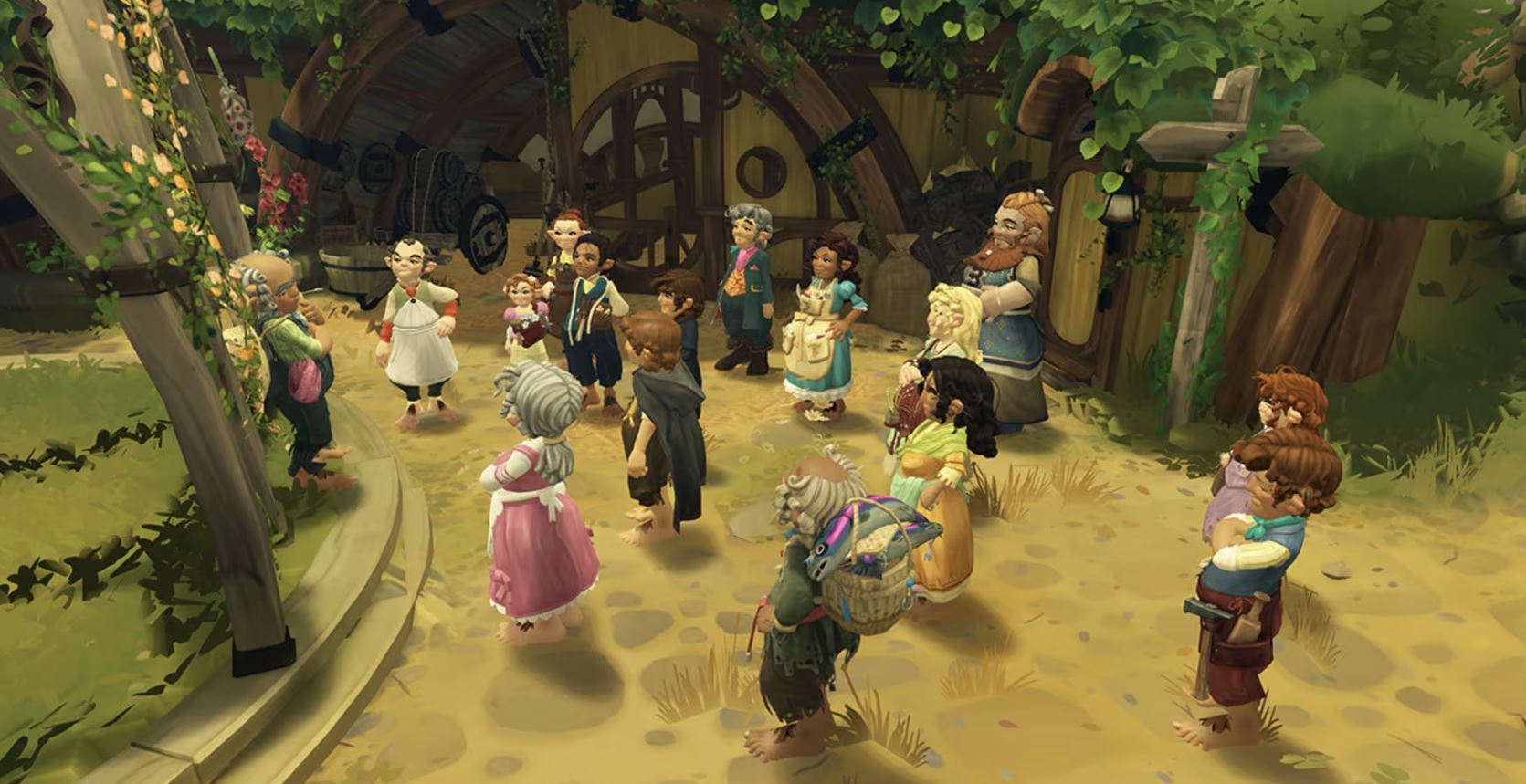
If there was ever a licensed property that feels right at home with a family-friendly farming simulator game, it’s The Lord of the Rings and author J.R.R. Tolkien’s iconic fantasy realm of Middle-earth. Wētā Workshop, the special effects and prop company behind filmmaker Peter Jackson’s The Lord of the Rings and The Hobbit trilogies, is teaming up with publisher Private Division for the upcoming farming and life simulator Tales of the Shire: A The Lord of the Ring Game. What comes is a familiar digital recreation of the Shire, as seen in the movies, for players to explore and create their own cozy household, becoming a prominent part of the rural hobbit community at their own low-stakes pace.
Tales of the Shire follows a player-created hobbit as they relocate from the town of Bree to Bywater, an unincorporated hobbit village within the Shire, a region of Middle-earth predominantly populated by hobbits and relatively untouched by the malevolence seen beyond its borders. Moving into a dilapidated home on the outskirts of town, the player character begins renovating their new digs while befriending their neighbors and learning about the local lore and gossip. As players get to know their new surroundings better, they discover a bevy of secrets around the Shire expanding the world and their place in Middle-earth.
Creating A Farming Sim for Middle-earth
Den of Geek got the opportunity to play an early preview build of Tales of the Shire, exploring the Shire and rebuilding a homestead overlooking the pastoral community. While there is certainly an emphasis on agriculture and crafting – like much of Tolkien’s text and themes – so much of Tales of the Shire involves achieving harmony with nature, with winding paths often running through the winds or along vast fields and bubbling creeks. To build these immersive environments, Wētā Workshop developers looked at the official maps of Middle-earth as well as Tolkien’s rich text elaborating on the world he created.
“Tolkien’s descriptions are so vivid, you could read them, close your eyes, and imagine hitting up the South Plains cotton farm and going up the steps to the farm,” reflects Wētā Workshop senior 3D game artist Kurt Adams. “Tolkien had thought this through and everything starts to fit together.”
More than gorgeously rendered landscapes, this harmony with nature carries over to the presence of flora and fauna organically built into the game mechanics themselves. Birds subtly help guide players to important points on the world map, fishing is a crucial part of the activities around the Shire, and a mix of cultivated and wild plant life enriches the overall experience as players prepare the farm around their homes and forage for more goods to trade with or consume themselves.
Joining The Hobbit Community
Right from the outset of the preview, the player character is tasked with meeting their neighbors and getting to know the many eclectic hobbits throughout the Shire. Many hobbits welcome the Shire’s newest resident with open arms while some are more ornery and foreclosed of suddenly getting a neighbor from Bree potentially disrupting their idyllic rustic community. More than just building harmony with the various hobbits in the Shire, befriending and earning the trust of your neighbors in Tales of the Shire also leads to access to secret locations across the region (from secluded fishing holes to spots with rare objects and collectibles for the player to recover). This all provides tangible rewards for the community-building and friendship aspect of Tales of the Shire along with the importance of interacting with NPCs for a fuller experience.
“You need to communicate and be in conversations with certain characters so that they will trust you and let you into these secret areas,” explains Adams. “That was something really fun that I worked with the designers and we had a lot of fun making secret fishing locations and secret cranberry bogs to find and forage from.”
The quickest and most effective way to earn any hobbit’s favor and trust is through their stomach. Preparing anything from a second breakfast to a hearty supper to share with the neighbors. Players do this by mixing ingredients they gather, unlocking more rewarding recipes as they progress through the game and continue to make friends. Players can also socialize with their neighbors at Shire mainstays like the Green Dragon tavern, which will lead to conversations providing more context about this world and where in the Middle-earth timeline Tales of the Shire takes place, with Adams hinting at “many” hints at Bilbo Baggins’ exploits and “throughout the whole story” that establish the game’s place in the wider universe.
Cozy Game, Cozy Stakes
Like virtually any video game, Tales of the Shire has quests or missions for players to accomplish around the Shire (aptly dubbed “tales” within the game’s parlance). These can range from learning more about the history and politics within the community by learning about an ancient text or learning how to fish to complete a neighbor’s favorite recipe. While there is an in-game clock, progressing steadily through a day and night cycle, there is no ticking time limit to complete these tales, with the developers encouraging players to enjoy the game at their own pace.
“There’s no rush in the Shire,” Adams observes. “You’ve got a lot of time to do things. We want to reduce the feeling of anxiety of having to get anything done.”
Much like how the Shire provides Gandalf – who does appear in the game – with a tranquil respite from the darker side of Middle-earth, there is a warm and inviting quality to the Shire’s design and the game’s overall animation style. Slightly cartoony but within the visual aesthetics of the Shire and hobbits as seen in Jackson’s films, Wētā Workshop consciously leaned for a welcoming presentation that shied away from the more mature elements of the movies and let players relax and enjoy the world they created, with a color palette reminiscent of impressionist painters like Renoir and Cézanne.
“We wanted to land on an art style that was appropriate for this cozy narrative life simulator,” Adams explains. “We’ve worked on the movies and props in the films and there was a lot of darkness in the films and that suits a certain look but, in this cozy world, we wanted a cozy, warm, and vibrant appearance for things. We approached it with having a sort of painterly, dream-like quality.”
Tales of the Shire and the State of The Farming Sim
Tales of the Shire comes out at a time when the genre is ruled by the perennially popular indie game Stardew Valley and with Disney bringing their own properties to the genre with Disney Dreamlight Valley. And while there are certainly similarities between Tales of the Shire and its contemporaries, including dividing the calendar into seasons rather than months and the game’s tool wheel, Tales of the Shire does feel like its own distinct take on the farming simulation genre couched within the familiarity of Tolkien’s Middle-earth. Even as an early build, the preview shows a lot of promise of what the final game will ultimately be and it’ll be interesting to see how Wētā Workshop expands and refines this digital vision of the Shire.
Even without the Tolkien license, Tales of the Shire feels like a solidly built farming simulator that embraces nature and its jovial NPCs with a warm animation aesthetic. By officially setting the game within Middle-earth, though, the overall game is elevated significantly. Any Tolkien fan who appreciates a more relaxed and casual gaming experience will definitely want to check out the game when it launches on multiple platforms this March. Tales of the Shire doesn’t seek to reinvent the farming sim wheel but lovingly create a world that literary and cinema fans will immediately recognize and invite them to join in with this serene community.
Tales of the Shire: A The Lord of the Rings Game launches March 25 for PC via Steam, Nintendo Switch, PlayStation 5, Xbox Series X|S, and Netflix Games.
The post Tales of the Shire Lets You Finally Live the Dream of Being a Hobbit appeared first on Den of Geek.







